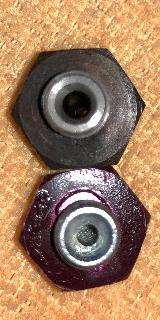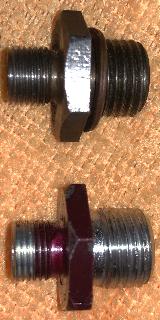The MGA With An Attitude
OIL PRESSURE GAUGE Port Fitting on Engine -- DT-104B
11G15 Union, oil pressure gauge pipe
On 1/21/2020, Robert Kuhn wrote:
"I ordered a replacement from Moss, then found the original one, and noticed they are different. The original union, when I blew through it from the intake side greatly restricted my breath. When I blew into the Moss part on the intake side there was a marked difference by probably 15% - 20%, definitely a lot easier to blow through. As this seems to be the restriction point to meter the pressure to the gauge, wouldn't the Moss part show you a higher pressure on the gauge than the original as it allows a higher flow"?



New fitting from Moss Motors on top. Original factory fitting on bottom.
Not a problem either way. The little hole is an intentional restrictor to damp out pulsation in the oil to prevent jumpy needle in the pressure gauge. Bore in the connecting hose is fairly small. Farther down stream the bore of the connecting pipe to the gauge is even smaller. There may also be a restrictor orifice in the connection fitting between the hose and the gauge pipe, and another restrictor on the back of the gauge (or just very small bore holes all along the circuit). Flow rate through these fittings is nearly nil. When oil pressure goes from 0 to 60 psi the gauge will accept maybe one gram of oil to make the gauge operate. When engine stops that gram of oil goes back to the engine.
Once everything is assembled you should run the engine for oil pressure, then switch off. Disconnect the pipe from back of gauge, hold it over a little cup, run the engine again, and wait for a teaspoon of oil to come out of the pipe, like bleeding air out of a brake line, then switch off engine and reconnect the pipe to the gauge. If you left air in that pipe the gauge response would be slow, like taking too long for pressure to build up when the engine is started, because it takes time to compress the air with the slow oil flow. With no air in the pipe the gauge response is much quicker.
|